Naderi Production
2 HANNERT DE KLEPPBEEM
L-6995 RAMELDANGE

In today’s fast-paced world, smartphones have become our constant companion, and we love to capture every moment with our cameras. With the advanced features of modern smartphones, anyone can be a photographer. Smartphone photography has become a trend and has given birth to new genres like ‘selfie,’ ‘food photography,’ and landscape photography. If you are interested in this field and want to improve your smartphone photography skills, we have some tips for you.
By following these simple tips, you can improve your smartphone photography skills and capture amazing photos. Remember, the most important thing is to have fun and experiment with different techniques to find your style. Happy clicking!
Slowly, but surely, compact cameras are being replaced by cell phones as a result. Gone are the days when we need to carry a separate point and shoot – now just grab your smartphone from your pocket and you are good to go. Smartphones are so lightweight and portable, that capturing photos has never been easier. Plus, you always carry one with you.
I believe that phone photography is not aimed to be perfect in execution – rather, I try to capture the mood and look forward for nice compositions, which is the actual key for any good photo. Generally, you have a complete automated mode with which most of the people shoot. There might be other modes available such as landscapes and portraits on some phones, but they all feel the same to me and seem more like effects rather than actual changes in exposure. I would not worry about camera effects and would rather shoot as flat as possible and alter contrast and saturation later in post. So all you need to do is just click the capture button at the right moment. Do your best to properly frame your shot and look for a good composition beforehand. Turning on composition lines such as the rule of thirds will help in positioning your subject(s).
Phones cameras obviously lack behind larger cameras in portraiture. Forget about shallow depth of field and creamy bokeh, because you are dealing with a short focal length lens on a tiny sensor, so your depth of field is practically always infinite. However, for landscapes and other photography genres, smartphones work great. Phones are also unusable for capturing fast action, as they don’t offer super fast shutter speeds and autofocus speed / subject tracking are not fast enough, but still, the technology is gradually improving and smartphones are getting better.
In addition, noise levels are much higher, particularly when shooting in low light environments. Although most phone cameras come with built-in flash units, I personally never use flash, as it adds very flat lighting on your subject and often creates really harsh shadows, which are just not pleasing to look at. So my recommendation is to turn flash off and only use it when absolutely necessary…
You can also use different filters than are available, which can sometimes give pretty good instant results, but don’t push the opacity of that filter slider all the way up. Try around 50 percent opacity and lower, and keep things very subtle.
Finally, when you are done processing your images, now it’s time to share them! There are plenty of great platforms on which you can showcase your phone photography, whether it is in the form of social media such as Facebook and Instagram, or various sites hosting photo contests specifically for phone photography. It is a lot of fun photographing with a phone and the possibilities are endless!
If you have any questions or feedback, please post your comments in the comments section below.